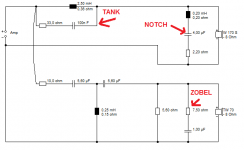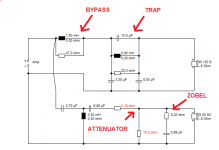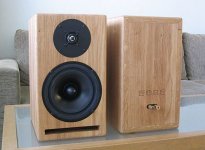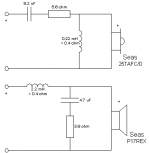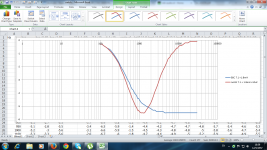But none of you flipping geniuses are helping prescott
with his blooming SEAS bass unit.
Presscot in post #30 seems to be delighted to have his issue sorted out.
Presscot in post #30 seems to be delighted to have his issue sorted out.
Nah, mate. He's still got an issue with Barbara Streisand cracking his china on high notes. Funny Girl, that one... 😀
Anyway, you obviously missed my last post.
http://www.diyaudio.com/forums/multi-way/255874-notch-filter-midrange-6.html#post3923576
We're there now! 😎
A series network has the filter components in series and the network is parallel to the driver.
A parallel network has the filter components in parallel and are in series with the driver.
I couldn't have said it any clearer than this and that was 40 posts ago. I am beginning to think there is a language problem.
I couldn't have said it any clearer than this and that was 40 posts ago.
I am beginning to think there is a language problem.
Hi,
No language problem. Your dealing in dogmatic incorrect definitions.
You will find loads of examples of incorrect usage in this case.
They are are all in any strict sense wrong.
Radio which uses loads of resonant circuits, knows the difference
between the filter position and the type of filter, and in radio due
to different purposes a series filter can be a series type, and
a parallel filter a parallel type, to exacerbate resonance.
That so many people get it wrong, does not make it right.
The idea that a "series" filter actually means parallel connection,
and a "parallel" filter actually means series connection is as
ludicrous as it sounds in any plain language, and just wrong.
rgds, sreten.
Last edited:
Yes, true but how could you help him without measurements?
It's like instructing him via a cell phone to turn right or left when he's driving on the wrong side of the highway..... 😉
Regards
/Göran
That's because there's always plenty of opinions on this forum regardless if they are helpful or not. Yep the OP needs to learn how to measure first so he has a basic foundation to build upon. Anything else is going to be guess work.
Well I might being picky but...No language problem.
I believe you mean you'reYour
Then stop it.dogmatic incorrect definitions.
Your definition goes against what I was taught many years ago, nothing has changed.They are are all in any strict sense wrong.
Stop being the one who changes the world, the definition is fine.That so many people get it wrong, does not make it right.
I go with the accepted definition, that that the term applies to the filter, not the application. Why is that wrong Sreten?The idea that a "series" filter actually means parallel connection,
and a "parallel" filter actually means series connection is as
ludicrous as it sounds in any plain language.
I go with the accepted definition, that that the term applies
to the filter, not the application. Why is that wrong Sreten?
Hi,
I don't agree your perception its the accepted definition,
in any rigourous sense, its a common misunderstanding.
Try using it analysing / describing a radio circuit and
see how far you get ignoring the "application".
The typical series LCR used on a tweeter is a parallel
impedance conjugate and is simply a parallel filter.
Describing it as a series filter is just the implementation
of the conjugate parallel filter, which is not that useful.
Such a description on its own loses any accuracy.
rgds, sreten.
Last edited:
Steve's post 9 has a series notch on the woofer in attachment 2.
A pararallel notch. The filter is in parallel with the driver and shunts a range of frequencies past the driver.
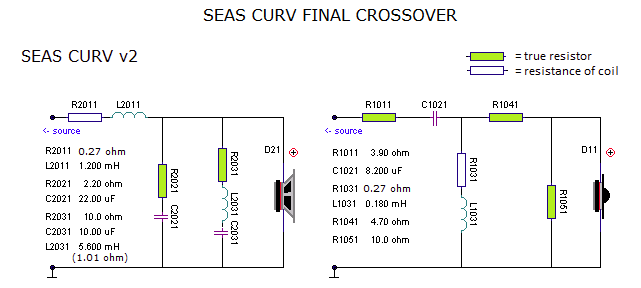
dave
I have achieved with a Baffle Step correction (BSC).
BSC filter is a seriesnotch filter with an infiniste cap... no HF corner.
dave
Aw, boys! This is SO boring!
Learn to call the elements their proper names and you won't worry about series and shunt, or series and parallel! 😀
BTW, while you have been taking pedantry to astronomical heights, I must tell you that me and sreten, working together as a team, have solved the problem of Barbara Streisand shrieking on presscot's SEAS bass whilst BeeGeeing it up on Guilty.
Marvellous. Problem fixed. 😀
Learn to call the elements their proper names and you won't worry about series and shunt, or series and parallel! 😀
BTW, while you have been taking pedantry to astronomical heights, I must tell you that me and sreten, working together as a team, have solved the problem of Barbara Streisand shrieking on presscot's SEAS bass whilst BeeGeeing it up on Guilty.
Marvellous. Problem fixed. 😀
Attachments
Hi, Update again 😎
Now, I found an astonishing thing. After reading someone's talking about an enclosure and damping material, PLB's #35, bringing me to thought back to an enclosure. I've already known that there are negative speakers available in this world. See this link - http://www.jblpro.com/pub/technote/tn_v1n12b.pdf. And also you can type "jbl reversed polarity speaker" in google , if you want to know more about it. 😉
I thought the effect of too much and hard-to-control mid-frequency that occurring to me was perhaps caused by an enclosure! And my speaker once found ,before replacing the woofer, tweeters were wired out of phase -- but it isn't involve to a 2nd order issue because I've tested it already by reversing(out of phase to the woofer) and non-reversing tweeter's polarity, the latter give me better sound. So, it is worth to question that is it possible if my speakers are negative-type! (Remember my speakers were born on 1980s) Thus, I had reconnected the speaker wire of EACH drivers from red : + to - ,and black : - to +. (In fact, you can just tried the swap at speaker terminal or outer speaker wire but it's suggested that the capacitor, resistor,and inductor should be placed before the drivers) And then look what I've found, the speakers seem to have better tonal balance. 😱 The vocal seems smoother although the impact was lesser but that can bring me to be more relaxed and listen to this speaker for a longer time.
And my speaker once found ,before replacing the woofer, tweeters were wired out of phase -- but it isn't involve to a 2nd order issue because I've tested it already by reversing(out of phase to the woofer) and non-reversing tweeter's polarity, the latter give me better sound. So, it is worth to question that is it possible if my speakers are negative-type! (Remember my speakers were born on 1980s) Thus, I had reconnected the speaker wire of EACH drivers from red : + to - ,and black : - to +. (In fact, you can just tried the swap at speaker terminal or outer speaker wire but it's suggested that the capacitor, resistor,and inductor should be placed before the drivers) And then look what I've found, the speakers seem to have better tonal balance. 😱 The vocal seems smoother although the impact was lesser but that can bring me to be more relaxed and listen to this speaker for a longer time.
Back to my circuit issue, now I'm happy with my current circuit - BSC for my SEAS. It works very well. And the problem also seem to be fixed 😉. Or if a little adjustment would be required, it probably replacing a 1 ohm resistor to much higher value; I've 1.8 ohm one in my store
It works very well. And the problem also seem to be fixed 😉. Or if a little adjustment would be required, it probably replacing a 1 ohm resistor to much higher value; I've 1.8 ohm one in my store  but haven't done it)
but haven't done it)
Attached image : I just post to you my auxiliary. Lol 😀
Now, I found an astonishing thing. After reading someone's talking about an enclosure and damping material, PLB's #35, bringing me to thought back to an enclosure. I've already known that there are negative speakers available in this world. See this link - http://www.jblpro.com/pub/technote/tn_v1n12b.pdf. And also you can type "jbl reversed polarity speaker" in google , if you want to know more about it. 😉
I thought the effect of too much and hard-to-control mid-frequency that occurring to me was perhaps caused by an enclosure!
 And my speaker once found ,before replacing the woofer, tweeters were wired out of phase -- but it isn't involve to a 2nd order issue because I've tested it already by reversing(out of phase to the woofer) and non-reversing tweeter's polarity, the latter give me better sound. So, it is worth to question that is it possible if my speakers are negative-type! (Remember my speakers were born on 1980s) Thus, I had reconnected the speaker wire of EACH drivers from red : + to - ,and black : - to +. (In fact, you can just tried the swap at speaker terminal or outer speaker wire but it's suggested that the capacitor, resistor,and inductor should be placed before the drivers) And then look what I've found, the speakers seem to have better tonal balance. 😱 The vocal seems smoother although the impact was lesser but that can bring me to be more relaxed and listen to this speaker for a longer time.
And my speaker once found ,before replacing the woofer, tweeters were wired out of phase -- but it isn't involve to a 2nd order issue because I've tested it already by reversing(out of phase to the woofer) and non-reversing tweeter's polarity, the latter give me better sound. So, it is worth to question that is it possible if my speakers are negative-type! (Remember my speakers were born on 1980s) Thus, I had reconnected the speaker wire of EACH drivers from red : + to - ,and black : - to +. (In fact, you can just tried the swap at speaker terminal or outer speaker wire but it's suggested that the capacitor, resistor,and inductor should be placed before the drivers) And then look what I've found, the speakers seem to have better tonal balance. 😱 The vocal seems smoother although the impact was lesser but that can bring me to be more relaxed and listen to this speaker for a longer time.Back to my circuit issue, now I'm happy with my current circuit - BSC for my SEAS.
 It works very well. And the problem also seem to be fixed 😉. Or if a little adjustment would be required, it probably replacing a 1 ohm resistor to much higher value; I've 1.8 ohm one in my store
It works very well. And the problem also seem to be fixed 😉. Or if a little adjustment would be required, it probably replacing a 1 ohm resistor to much higher value; I've 1.8 ohm one in my store  but haven't done it)
but haven't done it) Attached image : I just post to you my auxiliary. Lol 😀
Attachments
Last edited:
BSC filter is a seriesnotch filter with an infiniste cap... no HF corner.
dave
Yes, you're true. My auxiliary told me like this too. 🙂
Attachments
To repeat: Until you learn and use measurements to really find out what is going on, it's all guess work. There are threads on here with thousands of posts where people are only guessing instead of measuring.
Now as to the parallel/series notch filter controversy: You can have either a series notch filter in parallel with the driver or a parallel notch filter in series with the driver. Simple. Easy. Use this description and everyone will know what you mean.
Now as to the parallel/series notch filter controversy: You can have either a series notch filter in parallel with the driver or a parallel notch filter in series with the driver. Simple. Easy. Use this description and everyone will know what you mean.
Presscot, you may be reinventing the wheel here really. Those engineers at SEAS in Moss, on the edge of Oslofjord in Norway know what they are doing with their drivers. I would trust their design. It looks good to me.
They probably don't fancy a notch because of the closeness of the cone resonance to crossover.
But the trick here is to have sufficient rolloff from the BSC coil to lower the midrange energy. I would get a BSC coil around 2.2-2.5 mH. Everything else should then work without the detailed but shouty quality that too small coil gives.
I really quite like the Embla filter. You'll probably adjust the series resistor on the treble for top end level matching. 🙂
They probably don't fancy a notch because of the closeness of the cone resonance to crossover.
But the trick here is to have sufficient rolloff from the BSC coil to lower the midrange energy. I would get a BSC coil around 2.2-2.5 mH. Everything else should then work without the detailed but shouty quality that too small coil gives.
I really quite like the Embla filter. You'll probably adjust the series resistor on the treble for top end level matching. 🙂
BSC filter is a seriesnotch filter with an infiniste cap... no HF corner.
dave
A BSC filter is a L||R in series with the driver. This is not a notch, but a cutting high shelf filter.
Not just semantics but also important to understand how these filters work and why they get their names.
Last edited:
A BSC filter is a L||R in series with the driver. This is not a notch, but a cutting high shelf filter.
Pretty much what i said ...
dave
Pretty much what i said ...
dave
Sorry, but the notch part sounded different.
Presscot, you may be reinventing the wheel here really. Those engineers at SEAS in Moss, on the edge of Oslofjord in Norway know what they are doing with their drivers. I would trust their design. It looks good to me.
They probably don't fancy a notch because of the closeness of the cone resonance to crossover.
But the trick here is to have sufficient rolloff from the BSC coil to lower the midrange energy. I would get a BSC coil around 2.2-2.5 mH. Everything else should then work without the detailed but shouty quality that too small coil gives.
I really quite like the Embla filter. You'll probably adjust the series resistor on the treble for top end level matching. 🙂
Thank you for advising, System7 😉
I have a 0.47mH and a 0.68 mH air-core coil in my hand. If I have some free time, I'll try it -- series with my current 1.8 mH coil. 🙂
For the SEAS drivers issue, I didn't reinvented anything anymore 'cause it just a trial 😀 -- just swap the speaker wire in order to loosen my doubt. And I didn't mean my SEAS drivers are negative-type, I do believe the engineers too, but I said those Denon maybe (in my assumption 🙂);perhaps by their enclosure design, damping materials design, etc.
Last edited:
- Status
- Not open for further replies.
- Home
- Loudspeakers
- Multi-Way
- Notch filter for midrange ???
